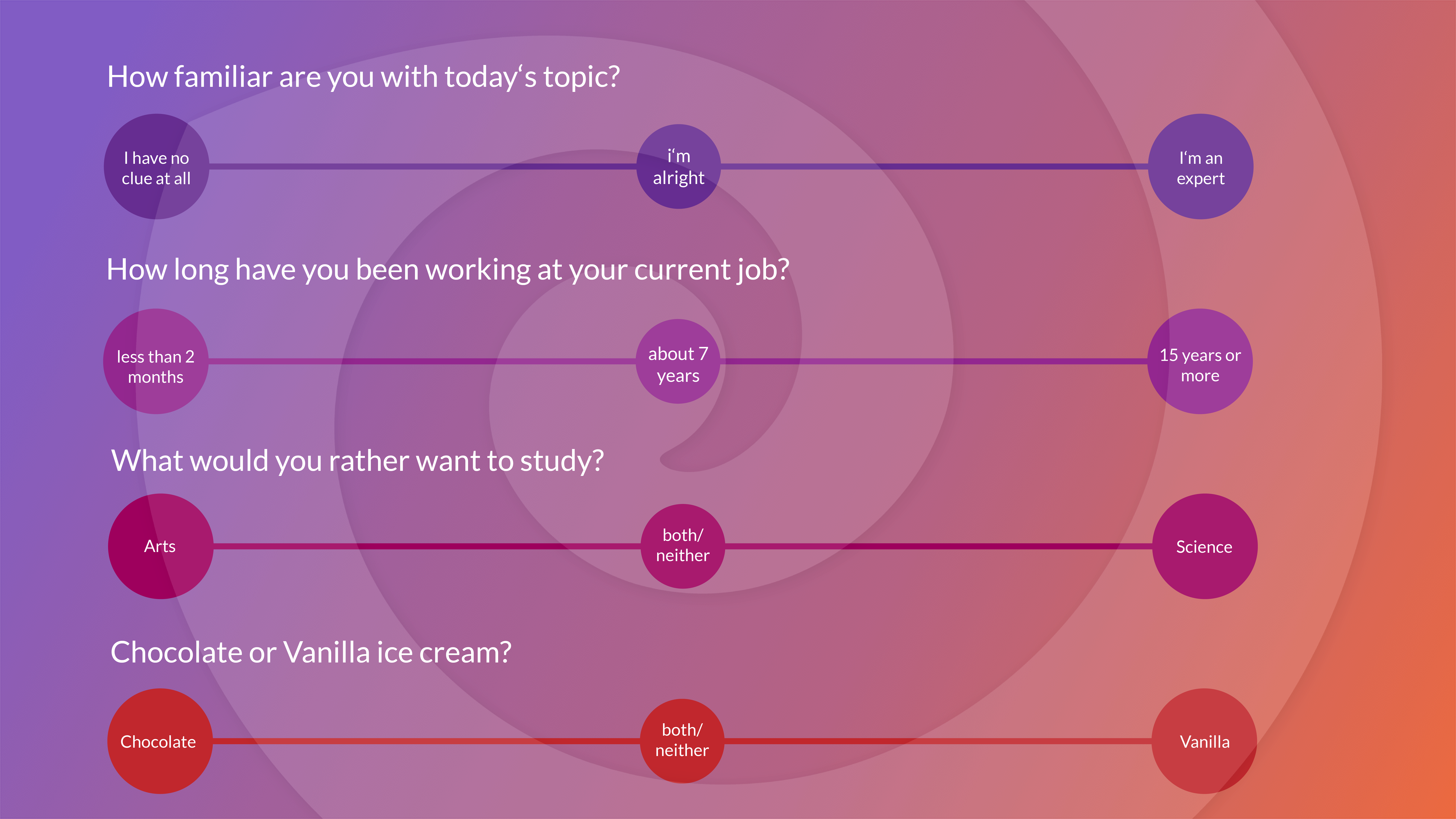In our last blog post, we talked about tools and tips on how to boost the audience engagement in your presentation. One of our recommended ways to do so was to play games, as they release tension and function as a fun element that lightens the mood. That’s why today we are going to list the Top 10 best games to play in your presentation.
- Contents
1. Would you rather
Is it a game that everyone knows already? Probably. But did we have to include it on the list because it is just perfect for playing with your audience? Definitely. The game is pretty much self-explanatory – You give your attendees two (or more)
scenarios and they have to choose which one they’d rather experience. Combining the Would you rather – question with your presentation topic is usually very easy, but we also thought of some questions you could use for any topic (e.g. as an icebreaker,
to get to know your audience a little better, to ask about their opinion or just as a fun element in between). You can let your audience vote by letting them raise their hands or by using an interactive poll tool such as SlideLizard.
- Would you rather A. travel back in time OR B. travel to the future OR C. stay in the present
- Would you rather A. have a long lunch break now OR B. have a short break and finish early
- Would you rather A. be able to read minds OR B. be able to fly OR C. be able to turn invisible
- Would you rather A. receive a letter from Hogwarts OR B. join Frodo on his journey OR C. Hog-what?
- Would you rather A. never be able to go on Social Media again B. never be able to read a book again

2. Charades
The popular game is not only great for your family’s game-night, but also for your presentations and workshops. Prepare a few cards that have words related to your presentation’s topic on them, let some volunteers in your audience draw and act them out. The rest of the audience has to guess the word. You can be sure that these terms and the associated performances will never be forgotten!

3. Quizzes
Small Trivia quizzes are perfect for checking and manifesting the audience’s knowledge at the end of your presentation. Instead of repeating and summing up what you have already said, you can let your participants test their knowledge right away.
However, you can also use a quiz in the beginning to test your audience’s existing knowledge about a topic. But there are not only trivia quizzes: Questions about personality can also be interesting and work well as an ice breaker in the beginning.
Again, we recommend a tool for poll creation, as that is the easiest way to conduct quizzes. In a recent article we listed 50 great questions (a mix of personality and trivia), that you could use for your next presentation! And if you're a fan of quiz game shows, we also got a full Who wants to be a Millionaire PowerPoint template for you to download for free! You'll see how it looks like in the following video (be sure to turn up your sound!):
4. Memory
PowerPoint can be used for way more than most people know. Even we were amazed by people on the internet who created extensive games by animating content using PP. We don’t want to go that big today, but we are going to provide you with a free-to-download template of memory. You only have to add it to your presentation and customize the pictures or terms you want under the cards.
Download free PPT Memory Template
5. Two Truths and a Lie
Here is another game that is just perfect when you play it with interactive poll tools. It is great for getting the audience to know you as a presenter better. Think of a fun, interesting or astonishing fact about yourself, and then invent two fake ones. Your attendees have to vote which statement they think is true. Be prepared to see some very surprised faces in your audience!

6. PowerPoint Karaoke
PowerPoint-Karaoke is the perfect improvisation game. Players are confronted with a set of slides they have never seen before and try to give a presentation as convincingly as possible. If you want to know all about this game and get some slides you can use for playing, check out our detailed blog post on PowerPoint-Karaoke.

7. Where do you stand?
For the game “Where do you stand?”, your attendees will actually have to stand up. Therefore, it is only convenient if you have enough space. If you want to get your participant’s opinion about something and get them to move a little, look no further! Create an imaginary line across the room. One end stands for one opinion, the other end for the exact opposite opinion. Your attendees can now place themselves on this line wherever they like (right in the middle, on either end or somewhere in between). You can then even interview people on the line (it is always interesting to choose two from opposite sites) and learn about their views. If you’re a little overwhelmed now, here are some examples you could use for this game:

Attention – you can of course ask about political or more controversial topics, but that may escalate and turn into a fight, which is not the purpose of the game or your presentation.
8. Describe That
Let your audience draw from cards with words on them and then describe it for the other attendees. It is basically like charades, but with words instead of acting. Some may find that too easy. In that case, you can either choose terms that are extremely hard to describe or add some “Taboo-words” to the card that can’t be used for describing.

9. True and False
Have you ever heard a crazy, bizarre fact where you didn’t think that it could be true? Perfect. You can use it in the well-known “True and False”-Game. You pick out a fact (ideally something related to your presentation topic) and then let your audience vote (you know – via an interactive poll tool like SlideLizard) if they think it’s true or not. A tip for making statements false: Change little things about the them, like numbers, dates or names or use common misconceptions and see how many of your attendees buy into them, e.g. “Bulls are enraged by the color red” (which is false, bulls are simply enraged by movement, not specific colors).

10. The never-ending sentence
The never-ending sentence is a great game that incorporates many of your attendees and awakens their brain cells. It is perfect for keeping up their engagement and interest, especially for long presentations or workshops when you feel like some people are getting a little tired. Simply start by saying a word – it can be related to the presentation’s topic if you want – and ask a person in your audience to repeat that word and add another one – the next person to repeat those two words and add another one as well , and so on, until a sentence forms. As it gets longer the game gets a lot more difficult, because there is a lot more to remember and to repeat. The sentence can’t be ended, it has to be continued until someone makes a mistake (or until the last person in the room has added a new word). We promise that you will be left with a lot of fun, creative, and straight-up weird sentences that will make your audience laugh a lot.






